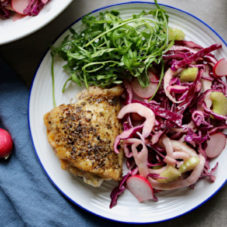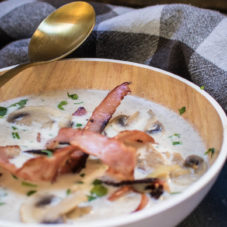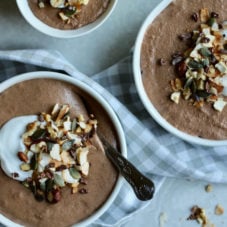Two of the most buzzworthy diets in the last few years are paleo (the paleolithic diet) and keto (the ketogenic diet). If you’re like me, you might have trouble keeping them straight! Let’s take a quick look at paleo vs keto and see what these diets have in common and what aspects are unique to each.
What is Paleo?
Essentially, the paleo diet is based on foods available to early humans during the Paleolithic era (as recent as about 10,000 years ago and stretching back as far as 2.5 million years!). As you can imagine, these foods are what we consider to be simple or even primitive – anything that could be foraged or hunted for, such as fruit, vegetables, and meat. Many people choose to “go paleo” for reasons like improved blood sugar balance, weight loss, gut health, and autoimmune health.
Foods restricted on paleo include grains, refined sugar, beans and legumes, potatoes, processed foods, salt, refined vegetable oils, and dairy products. Paleo is generally high-protein, high-fiber, and moderate in carbs (lower than the standard Western diet). Since processed foods are off-limits on paleo, the vast majority of carbs will come from fruits and vegetables.
 What is Keto?
What is Keto?
People embarking on the ketogenic diet typically are after one thing – weight loss. Of course, there are plenty of other health benefits, but shedding weight is by far the most popular reason to try keto. The aim of keto is to enter ketosis, which is a metabolic state where your body burns fatty acids instead of glucose for energy, producing ketones, which can help to produce rapid weight loss.
On keto, the focus is on your macros – and they may vary from person to person, but typically only about 5% of the calorie budget can come from carbs and as much as 75-80% must come from fat. While no particular food groups are completely off-limits on keto, restricting carb intake to such a minimal amount certainly makes you prioritize the small carb budget allowed. This means that you’ll likely need to limit fruits and vegetables in your diet and give up foods like grains, legumes, and rice.
Similarities
So far, these two diets sound quite different, right? Surprisingly, they do have quite a few aspects in common. Both diets:
- Avoid grains, legumes, and refined sugar
- Emphasize healthy fats such as seeds, avocados, and unrefined oils
- Promote adequate protein intake from animal sources
- Encourage low-carb vegetables and leafy greens.
 Paleo vs Keto: Differences
Paleo vs Keto: Differences
Of course, these diets do have more differences than similarities. Here are just a few:
- Keto focuses on macros, while paleo is more about the types of food consumed. Paleo isn’t particularly a low-carb diet, while keto certainly is.
- Paleo restricts dairy, while full-fat dairy products are an important part of the keto diet.
- Keto is done properly by testing for blood ketones to confirm ketosis, while following paleo only entails eating the specified types of food.
- Fruits and vegetables are unlimited on paleo, while they are heavily restricted on keto (with the exception of leafy greens and non-starchy vegetables).
Can You Do Paleo and Keto at the Same Time?
If you really wanted to, yes! It would be a very restrictive diet and require lots of planning ahead, but it is possible. A paleo-keto diet looks like this:
- Eliminate dairy products except ghee and grass-fed butter
- If you need to use a sweetener, choose a zero-calorie natural sweetener (such as stevia)
- Opt for pasture-raised or grass-fed animal proteins if available
- Limit your carbs to stay within your daily keto macros in order to enter and maintain ketosis.
So what does all of this mean? Basically, if weight loss is what you’re looking for, keto is probably your better option. You can certainly lose weight on paleo, but most people choose to follow it for assorted health reasons or personal preference.
 Paleo vs Keto: Which One Is Better for Weight Loss?
Paleo vs Keto: Which One Is Better for Weight Loss?
If you’ve decided to shred that couple of pounds before summer, you’re probably looking for an effective diet plan that will help you keep the weight off! There’s no point in going through the entire process if the weight will come back as soon as you start eating carbs, right?
Well, when it comes to losing weight – both diets will give fantastic results. First comes the water weight, and then comes the excess fat. But, after you’re done with the restrictive regime, you need to find a way to keep the weight off. That means that you need to choose a sustainable diet that will become a part of your lifestyle.
So, which one will help you lose more weight, and more quickly?
If you eat high-carb, full-fat meals every night and then switch to Paleo or Keto, both diets will do wonders! But you need to remember that just doing Paleo doesn’t guarantee you’ll lose the weight. Paleo includes a lot of fantastic food – nutritious fruits and veggies, but if you don’t pay attention to calories, you are not going to lose weight. You especially need to be careful if you have a habit of snacking high-calorie treats like walnuts, hazelnuts, or pistachios. You may even gain weight on Paleo if you’re not careful enough!
When it comes to paleo vs keto weight loss effectiveness, surely keto is the winner. People on keto usually don’t worry about calories, because they tend to eat less. Also, the very process of Ketosis helps you shred the weight (you are using fat as fuel!). On top of that, it’s highly unlikely that you’ll snack on roasted chicken, lettuce, or eggs. And since carbs are off the limits – you’ll really end up eating less.
There is another psychological perk when it comes to the keto diet. Because the results come very fast (you can literally see the difference within one week), you’ll end up feeling motivated to continue the keto journey. The result is losing more weight.





